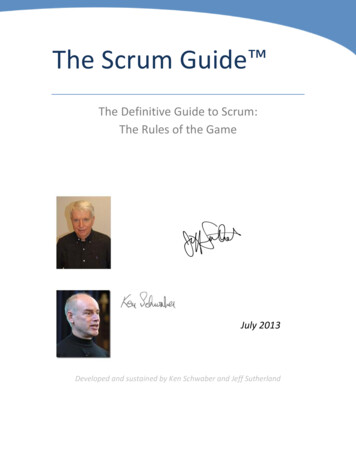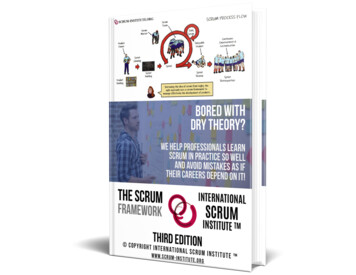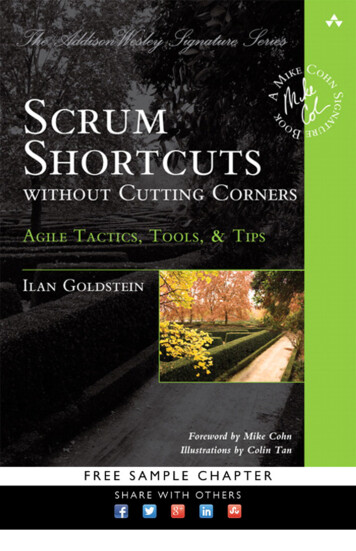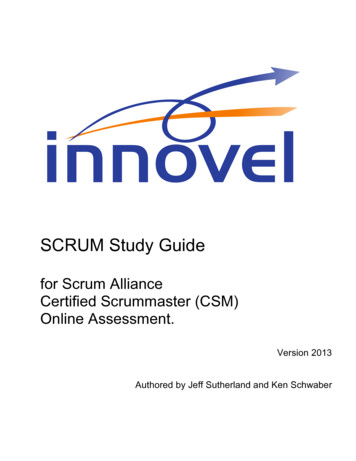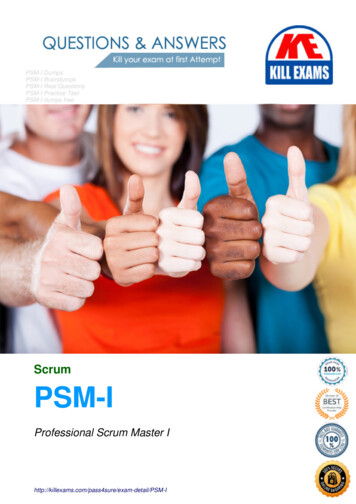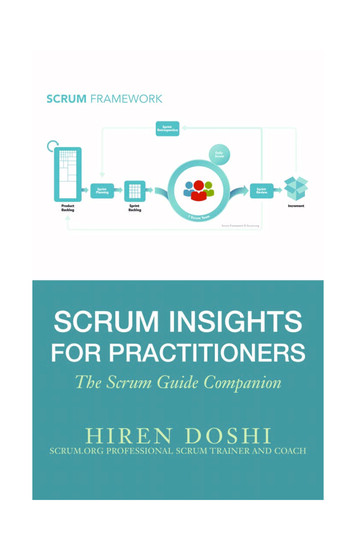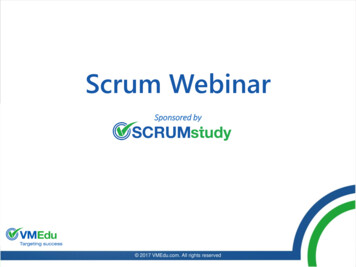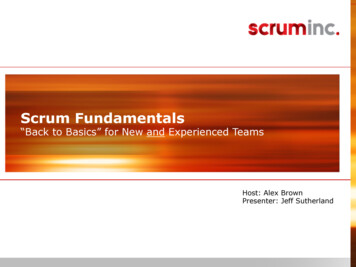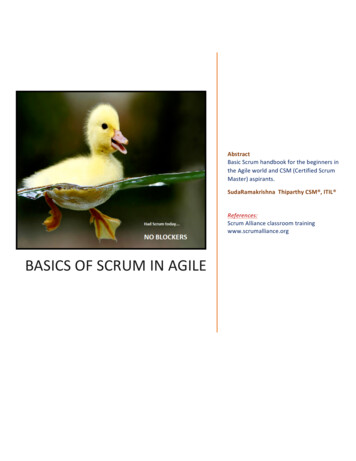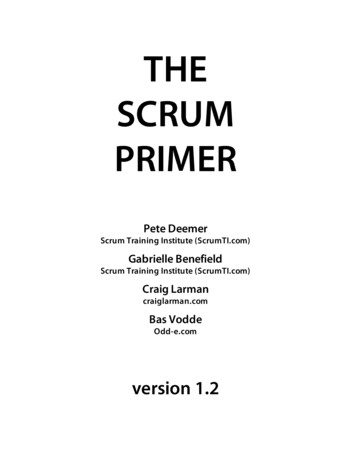
Transcription
THESCRUMPRIMERPete DeemerScrum Training Institute (ScrumTI.com)Gabrielle BenefieldScrum Training Institute (ScrumTI.com)Craig Larmancraiglarman.comBas VoddeOdd-e.comversion 1.2
A note to readers: There are many concise descriptions of Scrum available online, and thisprimer aims to provide the next level of detail on the practices. It is not intended as the finalstep in a Scrum education; teams that are considering adopting Scrum are advised to equipthemselves with Ken Schwaber’s Agile Project Management with Scrum or Agile Software Developmentwith Scrum, and take advantage of the many excellent Scrum training and coaching options thatare available; full details are at scrumalliance.org. Our thanks go to Ken Schwaber, Dr. JeffSutherland, and Mike Cohn for their generous input. 2010 Pete Deemer, Gabrielle Benefield, Craig Larman, Bas Vodde2
Traditional Software DevelopmentThe traditional way to build software, used by companies big and small, was a sequential lifecycle commonly known as “the waterfall.” There are many variants (such as the V-Model), butit typically begins with a detailed planning phase, where the end product is carefully thoughtthrough, designed, and documented in great detail. The tasks necessary to execute the designare determined, and the work is organized using tools such as Gantt charts and applicationssuch as Microsoft Project. The team arrives at an estimate of how long the development willtake by adding up detailed estimates of the individual steps involved. Once stakeholders havethoroughly reviewed the plan and provided their approvals, the team starts to work. Teammembers complete their specialized portion of the work, and then hand it off to others inproduction-line fashion. Once the work is complete, it is delivered to a testing organization(some call this Quality Assurance), which completes testing prior to the product reaching thecustomer. Throughout the process, strict controls are placed on deviations from the plan toensure that what is produced is actually what was designed.This approach has strengths and weaknesses. Its great strength is that it is supremely logical –think before you build, write it all down, follow a plan, and keep everything as organized aspossible. It has just one great weakness: humans are involved.For example, this approach requires that the good ideas all come at the beginning of therelease cycle, where they can be incorporated into the plan. But as we all know, good ideasappear throughout the process – in the beginning, the middle, and sometimes even the daybefore launch, and a process that does not permit change will stifle this innovation. With thewaterfall, a great idea late in the release cycle is not a gift, it’s a threat.The waterfall approach also places a great emphasis on writing things down as a primarymethod for communicating critical information. The very reasonable assumption is that if Ican write down on paper as much as possible of what’s in my head, it will more reliably makeit into the head of everyone else on the team; plus, if it’s on paper, there is tangible proof thatI’ve done my job. The reality, though, is that most of the time these highly detailed 50-pagerequirements documents just do not get read. When they do get read, the misunderstandingsare often compounded. A written document is an incomplete picture of my ideas; when youread it, you create another abstraction, which is now two steps away from what I think I meantto say at that time. It is no surprise that serious misunderstandings occur.Something else that happens when you have humans involved is the hands-on “aha” moment– the first time that you actually use the working product. You immediately think of 20 waysyou could have made it better. Unfortunately, these very valuable insights often come at theend of the release cycle, when changes are most difficult and disruptive – in other words, whendoing the right thing is most expensive, at least when using a traditional method.Humans are not able to predict the future. For example, your competition makes anannouncement that was not expected. Unanticipated technical problems crop up that force achange in direction. Furthermore, people are particularly bad at planning uncertain things farinto the future – guessing today how you will be spending your week eight months from nowis something of a fantasy. It has been the downfall of many a carefully constructed Gantt chart.In addition, a sequential life cycle tends to foster an adversarial relationship between thepeople that are handing work off from one to the next. “He’s asking me to build somethingthat’s not in the specification.” “She’s changing her mind.” “I can’t be held responsible forsomething I don’t control.” And this gets us to another observation about sequential3
development – it is not much fun. The waterfall model is a cause of great misery for thepeople who build products. The resulting products fall well short of expressing the creativity,skill, and passion of their creators. People are not robots, and a process that requires them toact like robots results in unhappiness.A rigid, change-resistant process produces mediocre products. Customers may get what theyfirst ask for (at least two translation steps removed), but is it what they really want once theysee the product? By gathering all the requirements up front and having them set in stone, theproduct is condemned to be only as good as the initial idea, instead of being the best oncepeople have learned or discovered new things.Many practitioners of a sequential life cycle experience these shortcomings again and again.But, it seems so supremely logical that the common reaction is to turn inward: “If only we didit better, it would work” – if we just planned more, documented more, resisted change more,everything would work smoothly. Unfortunately, many teams find just the opposite: the harderthey try, the worse it gets! There are also management teams that have invested theirreputation – and many resources – in a waterfall model; changing to a fundamentally differentmodel is an apparent admission of having made a mistake. And Scrum is fundamentallydifferent.Agile Development and ScrumThe agile family of development methods were born out of a belief that an approach moregrounded in human reality – and the product development reality of learning, innovation, andchange – would yield better results. Agile principles emphasize building working software thatpeople can get hands on quickly, versus spending a lot of time writing specifications up front.Agile development focuses on cross-functional teams empowered to make decisions, versusbig hierarchies and compartmentalization by function. And it focuses on rapid iteration, withcontinuous customer input along the way. Often when people learn about agile developmentor Scrum, there’s a glimmer of recognition – it sounds a lot like back in the start-up days, whenwe “just did it.”By far the most popular agile method is Scrum. It was strongly influenced by a 1986 HarvardBusiness Review article on the practices associated with successful product development groups;in this paper the term “Rugby” was introduced, which later morphed into “Scrum” in WickedProblems, Righteous Solutions (1991, DeGrace and Stahl) relating successful development to thegame of Rugby in which a self-organizing team moves together down the field of productdevelopment. It was then formalized in 1993 by Ken Schwaber and Dr. Jeff Sutherland. Scrumis now used by companies large and small, including Yahoo!, Microsoft, Google, LockheedMartin, Motorola, SAP, Cisco, GE, CapitalOne and the US Federal Reserve. Many teams usingScrum report significant improvements, and in some cases complete transformations, in bothproductivity and morale. For product developers – many of whom have been burned by the“management fad of the month club” – this is significant. Scrum is simple and powerful.Scrum SummaryScrum is an iterative, incremental framework for projects and product or applicationdevelopment. It structures development in cycles of work called Sprints. These iterations areno more than one month each, and take place one after the other without pause. The Sprintsare timeboxed – they end on a specific date whether the work has been completed or not, andare never extended. At the beginning of each Sprint, a cross-functional team selects items4
(customer requirements) from a prioritized list. The team commits to complete the items bythe end of the Sprint. During the Sprint, the chosen items do not change. Every day the teamgathers briefly to inspect its progress, and adjust the next steps needed to complete the workremaining. At the end of the Sprint, the team reviews the Sprint with stakeholders, anddemonstrates what it has built. People obtain feedback that can be incorporated in the nextSprint. Scrum emphasizes working product at the end of the Sprint that is really “done”; in thecase of software, this means code that is integrated, fully tested and potentially shippable. Keyroles, artifacts, and events are summarized in Figure 1.A major theme in Scrum is “inspect and adapt.” Since development inevitably involveslearning, innovation, and surprises, Scrum emphasizes taking a short step of development,inspecting both the resulting product and the efficacy of current practices, and then adaptingthe product goals and process practices. Repeat forever.Figure 1. ScrumScrum RolesIn Scrum, there are three roles: The Product Owner, The Team, and The ScrumMaster.Together these are known as The Scrum Team. The Product Owner is responsible formaximizing return on investment (ROI) by identifying product features, translating these intoa prioritized list, deciding which should be at the top of the list for the next Sprint, andcontinually re-prioritizing and refining the list. The Product Owner has profit and lossresponsibility for the product, assuming it is a commercial product. In the case of an internalapplication, the Product Owner is not responsible for ROI in the sense of a commercial5
product (that will generate revenue), but they are still responsible for maximizing ROI in thesense of choosing – each Sprint – the highest-business-value lowest-cost items. In practice,‘value’ is a fuzzy term and prioritization may be influenced by the desire to satisfy keycustomers, alignment with strategic objectives, attacking risks, improving, and other factors.In some cases, the Product Owner and the customer are the same person; this is common forinternal applications. In others, the customer might be millions of people with a variety ofneeds, in which case the Product Owner role is similar to the Product Manager or ProductMarketing Manager position in many product organizations. However, the Product Owner issomewhat different than a traditional Product Manager because they actively and frequentlyinteract with the Team, personally offering the priorities and reviewing the results each two- orfour-week iteration, rather than delegating development decisions to a project manager. It isimportant to note that in Scrum there is one and only one person who serves as – and has thefinal authority of – Product Owner, and he or she is responsible for the value of the work.The Team builds the product that the Product Owner indicates: the application or website,for example. The Team in Scrum is “cross-functional” – it includes all the expertise necessaryto deliver the potentially shippable product each Sprint – and it is “self-organizing” (selfmanaging), with a very high degree of autonomy and accountability. The Team decides what tocommit to, and how best to accomplish that commitment; in Scrum lore, the Team is knownas “Pigs” and everyone else in the organization are “Chickens” (which comes from a jokeabout a pig and a chicken deciding to open a restaurant called “Ham and Eggs,” and the pighaving second thoughts because “he would be truly committed, but the chicken would only beinvolved”).The Team in Scrum is seven plus or minus two people, and for a software product the Teammight include people with skills in analysis, development, testing, interface design, databasedesign, architecture, documentation, and so on. The Team develops the product and providesideas to the Product Owner about how to make the product great. In Scrum the Teams aremost productive and effective if all members are 100 percent dedicated to the work for oneproduct during the Sprint; avoid multitasking across multiple products or projects. Stableteams are associated with higher productivity, so avoid changing Team members. Applicationgroups with many people are organized into multiple Scrum Teams, each focused on differentfeatures for the product, with close coordination of their efforts. Since one team often does allthe work (planning, analysis, programming, and testing) for a complete customer-centricfeature, Teams are also known as feature teams.The ScrumMaster helps the product group learn and apply Scrum to achieve business value.The ScrumMaster does whatever is in their power to help the Team and Product Owner besuccessful. The ScrumMaster is not the manager of the Team or a project manager; instead, theScrumMaster serves the Team, protects them from outside interference, and educates andguides the Product Owner and the Team in the skillful use of Scrum. The ScrumMaster makessure everyone (including the Product Owner, and those in management) understands andfollows the practices of Scrum, and they help lead the organization through the often difficultchange required to achieve success with agile development. Since Scrum makes visible manyimpediments and threats to the Team’s and Product Owner’s effectiveness, it is important tohave an engaged ScrumMaster working energetically to help resolve those issues, or the Teamor Product Owner will find it difficult to succeed. There should be a dedicated full-timeScrumMaster, although a smaller Team might have a team member play this role (carrying alighter load of regular work when they do so). Great ScrumMasters can come from anybackground or discipline: Engineering, Design, Testing, Product Management, ProjectManagement, or Quality Management.6
The ScrumMaster and the Product Owner cannot be the same individual; at times, theScrumMaster may be called upon to push back on the Product Owner (for example, if they tryto introduce new deliverables in the middle of a Sprint). And unlike a project manager, theScrumMaster does not tell people what to do or assign tasks – they facilitate the process,supporting the Team as it organizes and manages itself. If the ScrumMaster was previously in aposition managing the Team, they will need to significantly change their mindset and style ofinteraction for the Team to be successful with Scrum.Note there is no role of project manager in Scrum. This is because none is needed; thetraditional responsibilities of a project manager have been divided up and reassigned amongthe three Scrum roles. Sometimes an (ex-)project manager can step into the role ofScrumMaster, but this has a mixed record of success – there is a fundamental differencebetween the two roles, both in day-to-day responsibilities and in the mindset required to besuccessful. A good way to understand thoroughly the role of the ScrumMaster, and start todevelop the core skills needed for success, is the Scrum Alliance’s Certified ScrumMastertraining.In addition to these three roles, there are other contributors to the success of the product,including functional managers (for example, an engineering manager). While their role changesin Scrum, they remain valuable. For example: they support the Team by respecting the rules and spirit of Scrum they help remove impediments that the Team and Product Owner identify they make their expertise and experience availableIn Scrum, these individuals replace the time they previously spent playing the role of “nanny”(assigning tasks, getting status reports, and other forms of micromanagement) with time as“guru” and “servant” of the Team (mentoring, coaching, helping remove obstacles, helpingproblem-solve, providing creative input, and guiding the skills development of Teammembers). In this shift, managers may need to change their management style; for example,using Socratic questioning to help the Team discover the solution to a problem, rather thansimply deciding a solution and assigning it to the Team.Starting ScrumThe first step in Scrum is for the Product Owner to articulate the product vision. Eventually,this evolves into a refined and prioritized list of features called the Product Backlog. Thisbacklog exists (and evolves) over the lifetime of the product; it is the product road map(Figure 2). At any point, the Product Backlog is the single, definitive view of “everything thatcould be done by the Team ever, in order of priority”. Only a single Product Backlog exists;this means the Product Owner is required to make prioritization decisions across the entirespectrum, representing the interest of stakeholders and influenced by the team.7
Figure 2. The Product BacklogThe Product Backlog includes a variety of items, primarily new customer features (“enable allusers to place book in shopping cart”), but also engineering improvement goals (“rework thetransaction processing module to make it scalable”), exploratory or research work (“investigatesolutions for speeding up credit card validation”), and, possibly, known defects (“diagnose andfix the order processing script errors”), if there are only a few problems. (A system with manydefects usually has a separate defect tracking system.) The Product Backlog can be articulatedin any way that is clear and sustainable, though either Use Cases or “user stories” are oftenused to describe the Product Backlog items in terms of their value to the end user of theproduct.The subset of the Product Backlog that is intended for the current release is known as theRelease Backlog, and in general, this portion is the primary focus of the Product Owner.The Product Backlog is continuously updated by the Product Owner to reflect changes in theneeds of the customer, new ideas or insights, moves by the competition, technical hurdles thatappear, and so forth. The Team provides the Product Owner with estimates of the effortrequired for each item on the Product Backlog. In addition, the Product Owner is responsiblefor assigning a business value estimate to each individual item. This is usually an unfamiliarpractice for a Product Owner. As such, it is something a ScrumMaster may help the ProductOwner learn to do. With these two estimates (effort and value) and perhaps with additionalrisk estimates, the Product Owner prioritizes the backlog (actually, usually just the ReleaseBacklog subset) to maximize ROI (choosing items of high value with low effort) orsecondarily, to reduce some major risk. As will be seen, these effort and value estimates maybe refreshed each Sprint as people learn; consequently, this is a continuous re-prioritizationactivity as the Product Backlog is ever-evolving.Scrum does not define techniques for expressing or prioritizing items in the Product Backlogand it does not define an estimation technique. A common technique is to estimate in termsof relative size (factoring in effort, complexity, and uncertainty) using a unit of “story points”or simply “points”.Over time, a Team tracks how much work it can do each Sprint; for example, averaging 26points per Sprint. With this information they can project a release date to complete all features,or how many features can be completed by a fixed date, if the average continues and nothingchanges. This average is called the “velocity” of the team. Velocity is expressed in the sameunits as the Product Backlog item size estimates.8
The items in the Product Backlog can vary significantly in size or effort. Larger ones arebroken into smaller items during the Product Backlog Refinement workshop or the SprintPlanning Meeting, and smaller ones may be consolidated. The Product Backlog items for theupcoming next several Sprints should be small and fine-grained enough that they areunderstood by the Team, enabling commitments made in the Sprint Planning meeting to bemeaningful; this is called an “actionable” size.One of the myths about Scrum is that it prevents you from writing detailed specifications; inreality, it is up to the Product Owner and Team to decide how much detail is required, and thiswill vary from one backlog item to the next, depending on the insight of the Team, and otherfactors. State what is important in the least amount of space necessary – in other words, do notdescribe every possible detail of an item, just make clear what is necessary for it to beunderstood. Low priority items, far from being implemented and usually “coarse grained” orlarge, have less requirements details. High priority and fine-grained items that will soon beimplemented tend to have more detail.Sprint PlanningAt the beginning of each Sprint, the Sprint Planning Meeting takes place. It is divided intotwo distinct sub-meetings, the first of which is called Sprint Planning Part One.In Sprint Planning Part One, the Product Owner and Team (with facilitation from theScrumMaster) review the high-priority items in the Product Backlog that the Product Owner isinterested in implementing this Sprint. They discuss the goals and context for these highpriority items on the Product Backlog, providing the Team with insight into the ProductOwner’s thinking. The Product Owner and Team also review the “Definition of Done” (whichwas established earlier) that all items must meet, such as, “Done means coded to standards,reviewed, implemented with unit test-driven development (TDD), tested with 100 percent testautomation, integrated, and documented.” Part One focuses on understanding what theProduct Owner wants. According to the rules of Scrum, at the end of Part One the (alwaysbusy) Product Owner may leave although they must be available (for example, by phone)during the next meeting. However, they are welcome to attend Part Two.Sprint Planning Part Two focuses on detailed task planning for how to implement the itemsthat the Team decides to take on. The Team selects the items from the Product Backlog theycommit to complete by the end of the Sprint, starting at the top of the Product Backlog (inothers words, starting with the items that are the highest priority for the Product Owner) andworking down the list in order. This is a key practice in Scrum: The Team decides how muchwork it will commit to complete, rather than having it assigned to them by the Product Owner.This makes for a more reliable commitment because the Team is making it based on its ownanalysis and planning, rather than having it decided by someone else. While the ProductOwner does not have control over how much the Team commits to, he or she knows that theitems the Team is committing to are drawn from the top of the Product Backlog – in otherwords, the items that he or she has rated as most important. The Team has the ability to lobbyfor items from further down the list; this usually happens when the Team and Product Ownerrealize that something of lower priority fits easily and appropriately with the high priorityitems.The Sprint Planning Meeting will often last a number of hours, but no more than eight hoursfor a four-week Sprint – the Team is making a serious commitment to complete the work, andthis commitment requires careful thought to be successful. The Team will probably begin the9
Sprint Planning Part Two by estimating how much time each member has for Sprint-relatedwork – in other words, their average workday minus the time they spend attending meetings,doing email, taking lunch breaks, and so on. For most people this works out to 4-6 hours oftime per day available for Sprint-related work. This is the team’s capacity for the upcomingSprint. See Figure 3.Figure 3. Estimating Available HoursOnce the capacity is determined, the Team figures out how many Product Backlog items theycan complete in that time, and how they will go about completing them. This often starts witha design discussion at a whiteboard. Once the overall design is understood, the Teamdecomposes the Product Backlog items into work. The Team starts with the first item on theProduct Backlog – in other words, the Product Owner’s highest priority item – and workingtogether, breaks it down into individual tasks, which are recorded in a document called theSprint Backlog (Figure 4). As mentioned, the Product Owner must be available during PartTwo (such as via the phone) so that clarification is possible. The Team will move sequentiallydown the Product Backlog in this way, until it’s used up all its estimated capacity. At the end ofthe meeting, the Team will have produced a list of all the tasks with estimates (typically inhours or fractions of a day).Scrum encourages multi-skilled workers, rather than only “working to job title” such as a“tester” only doing testing. In other words, Team members “go to where the work is” andhelp out as possible. If there are many testing tasks, then all Team members may help. Thisdoes not imply that everyone is a generalist; no doubt some people are especially skilled intesting (and so on) but Team members work together and learn new skills from each other.Consequently, during task generation and estimation in Sprint Planning, it is not necessary –nor appropriate – for people to volunteer for all the tasks “they can do best.” Rather, it isbetter to only volunteer for one task at a time, when it is time to pick up a new task, and toconsider choosing tasks that will on purpose involve learning (perhaps by pair work with aspecialist).All that said, there are rare times when John may do a particular task because it would take fartoo long or be impossible for others to learn – perhaps John is the only person with anyartistic skill to draw pictures. Other Team members could not draw a “stick man” if their lifedepended on it. In this rare case – and if it is not rare and not getting rarer as the Team learns,there is something wrong – it may be necessary to ask if the total planned drawing tasks thatmust be done by John are feasible within the short Sprint.Many Teams also make use of a visual task-tracking tool, in the form of a wall-sized task boardwhere tasks (written on Post-It Notes) migrate during the Sprint across columns labeled “NotYet Started,” “In Progress,” and “Completed.” See Figure 5.10
Figure 4. Sprint BacklogFigure 5. Visual Management - Sprint Backlog tasks on the wallOne of the pillars of Scrum is that once the Team makes its commitment, any additions orchanges must be deferred until the next Sprint. This means that if halfway through the Sprintthe Product Owner decides there is a new item he or she would like the Team to work on, hecannot make the change until the start of the next Sprint. If an external circumstance appearsthat significantly changes priorities, and means the Team would be wasting its time if itcontinued working, the Product Owner or the Team can terminate the Sprint. The Teamstops, and a new Sprint Planning meeting initiates a new Sprint. The disruption of doing this isusually great; this serves as a disincentive for the Product Owner or Team to resort to thisdramatic decision.There is a powerful, positive influence that comes from the Team being protected fromchanging goals during the Sprint. First, the Team gets to work knowing with absolute certaintythat its commitments will not change, that reinforces the Team’s focus on ensuringcompletion. Second, it disciplines the Product Owner into really thinking through the items heor she prioritizes on the Product Backlog and offers to the Team for the Sprint.By following these Scrum rules the Product Owner gains two things. First, he or she has theconfidence of knowing the Team has made a commitment to complete a realistic and clear set11
of work it has chosen. Over time a Team can become quite skilled at choosing and deliveringon a realistic commitment. Second, the Product Owner gets to make whatever changes he orshe likes to the Product Backlog before the start of the next Sprint. At that point, additions,deletions, modifications, and re-prioritizations are all possible and acceptable. While theProduct Owner is not able to make changes to the selected items under development duringthe current Sprint, he or she is only one Sprint’s duration or less away from making anychanges they wish. Gone is the stigma around change – change of direction, change ofrequirements, or just plain changing your mind – and it may be for this reason that ProductOwners are usually as enthusiastic about Scrum as anyone.Daily ScrumOnce the Sprint has started, the Team engages in another of the key Scrum practices: TheDaily Scrum. This is a short (15 minutes or less) meeting that happens every workday at anappointed time. Everyone on the Team attends. To keep it brief, it is recommended thateveryone remain standing. It is the Team’s opportunity to synchronize their work and reportto each other on obstacles. In the Daily Scrum, one by one, each member of the Team reportsthree (and only three) things to the other members of the Team: (1) What they were able to get donesince the last meeting; (2) what they are planning to finish by the next meeting; and (3) anyblocks or impediments that are in their way. Note that the Daily Scrum is not a status meetingto report to a manager; it is a time for a self-organizing Team to share with each other what isgoing on, to help them coordinate. Someone makes note of the blocks, and the ScrumMasteris responsible to help Team members resolve them. There is no discussion during the DailyScrum, only reporting answers to the three questions; if discussion is required it takes placeimmediately after the Daily Scrum in a follow-up meeting, although in Scrum no one isrequired
step in a Scrum education; teams that are considering adopting Scrum are advised to equip themselves with Ken Schwaber’s Agile Project Management with Scrum or Agile Software Development with Scrum, and take advantage of the many excellent Scrum training and coaching options t
